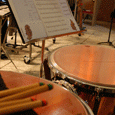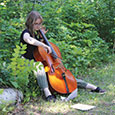Timpani are one of the most commonly used percussion instruments in school ensembles. Many notated parts for timpani look rather simple, consisting of relatively basic rhythms on predictable chord roots within the key of the piece. Percussionists may be able to play the pitches and rhythms of those parts fairly easily, but the resultant sound of the drums is what matters most. These five steps can make a noticeable difference in any timpanist’s playing.
Clear the heads and practice tuning.
My visits over the years to school rehearsal rooms suggest that percussionists and their directors often let the drums go out of tune, meaning that the tension at each of the lugs may not be producing the exact same pitch as all of the other lugs. If a given drum sounds out of tune, you can diagnose this yourself. Before beginning, make sure there is no visible damage to the head; if there is, replace it. Assuming a healthy head that is simply out of tune, a single stroke in the normal playing spot will produce beats in the sound just like two flutes that are slightly out of tune with each other. Tapping gently near each lug will usually highlight the culprit or culprits quickly. All lugs then need to be matched up precisely to clear the head.
First, make sure the drum is generally tightened to the appropriate lowest pitch when the pedal is all the way back (heel to the floor). If in doubt, check with the manufacturer or with a local percussion specialist to confirm the lowest pitches that your particular drums should match. Once set at the appropriate pitch, raise the pedal to the middle of the range and use a dependable pitch source to begin clearing the head.
Place a small piece of felt or other heavy fabric right in the center of the drum to isolate the sound of each lug from the others. Tap each of the lugs to discover which are sharp or flat and adjust them to the desired pitch. Some timpanists like to use a tuner for this process, placing it right next to each lug to gauge the number of cents of sharpness or flatness. Be sure to check the lugs in pairs across from each other on the drum, because adjusting one lug can affect its opposite. When the head is clear, it should maintain a pure pitch as it sustains, with no bending upward or downward after the initial attack.
Assuming the heads are clear, students should practice pedal tuning frequently. They should plan to spend some of their practice time without any mallets, just tuning various pitches using a pitch source and their internal relative pitch. I encourage timpani students to sing a lot; they should practice matching pitches they hear in daily life, such as car horns, elevator tones, or microwave beeps, until they can do so quickly and effortlessly.
When tuning the drums, make sure students always start below the pitch and tune up toward it, to ensure there is no slack left in the head. They should sing or hum the desired pitch, keep it in memory, and gently tap the drum as they raise the pedal until it matches. They can then check their tuning by humming the pitch directly into the drum from an inch or two above the playing spot. It should sing right back to them; if it sings back a bit flat or sharp, it is tuned slightly low or high, respectively. Quietly humming close to the drum is a great way to check pitch accuracy during a performance.
Use plenty of upstroke.
Compared to fundamental technique on the snare drum, timpani playing requires substantially more upstroke (i.e., pulling the mallets up on the rebound) for two reasons: the drums do not produce as much natural rebound and most timpani mallets are covered with felt. Players must provide additional upstroke to return the sticks to their ready position and avoid excess contact between the mallet felt and drumhead. Playing with additional upstroke also facilitates quick shifting among drums.
Students should experiment with the French grip when playing timpani. In the French grip, the standard matched grip for snare drum is turned 90 degrees, so that the thumbnails are facing up. This grip, commonly used by professionals, can offer expanded range of motion upward since the bulk of the hand is no longer on top of the mallet. Since timpanists rarely use any buzz or double-stroke rolls, the snare drum grip is not necessary. It should be noted, however, that German grip, which is essentially the same as matched grip on snare drum, is also used effectively by many timpanists. Both grips should be tried thoroughly so that students recognize the particular benefits of each. In any case, getting the felt mallets off the drums briskly on the rebound is crucial for general playing.
Practice the single-stroke roll thoroughly.
To sustain notes, timpanists generally use a single-stroke roll. While this is perhaps one of the first and simplest rudiments most percussionists learn, it requires specific attention when applied to timpani. The overarching goal for a good single-stroke roll is precise matching of the hands in rhythm and dynamics at various tempi. This becomes more challenging on the timpani, because the sizes of the drumheads produce relatively large vibration patterns. Students will find that a highly consistent single-stroke roll developed on a snare drum or practice pad may suddenly become somewhat erratic when applied to the timpani. The vibration patterns of the drums are a bit like the rolling sea, so any given stroke may be met by an unpredictable wave, gently surprising the students’ kinesthetic sense and making sensitivity to rebound especially important. Players must spend focused practice time on the drums establishing this sensitivity.
Several factors determine how fast timpanists should play a roll. Generally speaking, a roll on the lowest drum will be slower than on the highest drum, essentially matching the vibration pattern of each drum. This tip can easily be understood by rolling comfortably on the lowest drum and translating that roll speed directly to the highest drum; an unsatisfactory, “slow” rhythmic feeling will result. Even on a single drum the roll speed should change according to the same relationship; as the pitch is tuned up or down the roll speed will generally need to increase or decrease, respectively. Finally, roll speed may be determined by musical effect. A soft, low final bass note might be played rather slowly and calmly, while a tense moment at a musical climax might be played quickly and aggressively. In summary, timpanists should practice their single-stroke roll throughout the entire pitch range of all four drums, at a variety of dynamic levels according to musical effect.
Monitor playing spots.
To produce a full, resonant sound, timpanists must confine their playing spots to a relatively small area of the head. Rather than stating an estimated distance from the center or rim of each drum, I encourage students to use their ears to systematically find the best sound. They can play repeated strokes with one hand as they gradually move from the rim to the center of the drum and back. Playing at the rim will produce a thin, tinny sound and playing in the center will produce a sharp, dead sound. Neither of these is desirable unless specifically indicated by the composer. Students should recognize that the best playing spots will differ slightly depending on the size of the drum, but that the relationships are proportional. Once they have found the best spots, the drums should be positioned appropriately distant from their stool so that they will naturally target them accurately. When shifting among drums, timpanists need to be especially cognizant of their targets to get a full, even sound across the range of the instrument.
Students also must pay close attention to the matching of playing spots between their two mallets. It is essentially impossible to play with both mallets in exactly the same spot, so they need to choose symmetrical spots within the playing area. Think of this playing area as a concentric circular band of head surface and make sure the mallets are aligned equally within that band. When sustained rolls sound poor, for example, this is one of the first things to check. To discover and maintain properly matching playing spots, students can move the mallets gradually in and out of alignment to sharpen their perception of discrepancies and efficiency of correction.
Expand mallet selection and choose them appropriately.
Assuming that players have attended carefully to all prior suggestions, a final contribution to improved timpani sound is mallet choice. Many factors may combine to necessitate a particular mallet in a given musical situation, including the size of the drum, the pitch to which it is tuned, dynamics and articulations indicated, style and character of the passage, and overall orchestration. Students should have a wide variety of mallets differing in weight, balance, diameter of shaft, diameter and size of head, and material covering the head available in rehearsals.
Again, experimentation is the best way to discover which mallets work best in any given situation. Typically, soft heavy mallets work better for low dark rolls while thin hard mallets help to articulate faster rhythmic passages. However, quite often a particular pair of mallets can be surprisingly appropriate, in a way contrary to what one might generally suspect. Trying several pairs of mallets in rehearsal can help players and directors choose what will work best for performance. As with all tips presented here, there is no substitute for focused personal discovery of how these choices can improve timpani sound.







